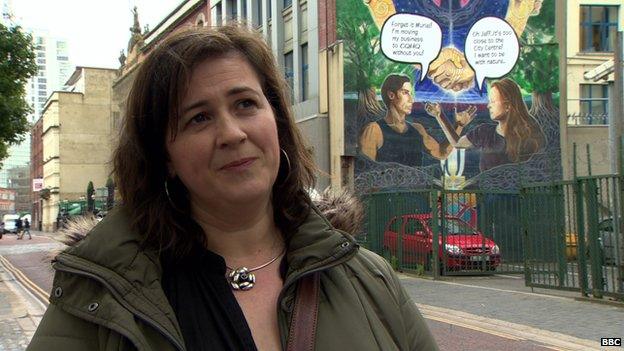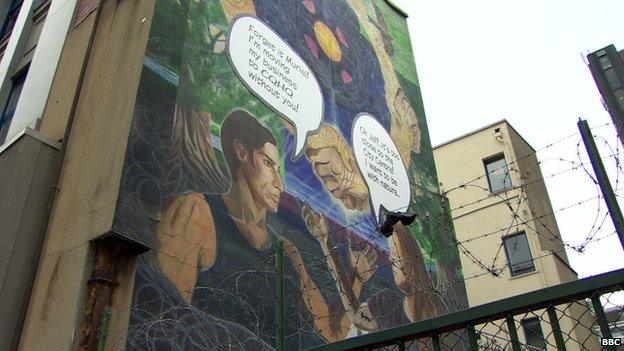Ring of Peace: Iconic Belfast mural 'speaks' with 'advertising' addition
- Published
Speech bubbles apparently advertising the services of a nearby firm have been added to the artwork
It is one of Belfast's biggest murals and a well-known feature in the city's Cathedral Quarter.
Ring of Peace was originally painted in 1998 to mark the Good Friday Agreement.
It is the work of the American-Chilean artist Francisco Letelier, and local artists from Queen Street Studios in the city.
Now the Waring Street mural has an unexpected new addition as its central characters have decided to speak.
Speech bubbles have been added, apparently advertising the services of a nearby firm.

Artist Jennifer Trouton said she was "horrified and shocked" when she noticed the mural's new look
Artist Jennifer Trouton worked on the mural, and she is unhappy that it has been altered.
"I was up and down the 60 foot scaffolding for several weeks in 1998, helping Francisco paint it," she said.
Prank
"It was very significant for me as I was a recent graduate and had studied in Belfast during the Troubles, so it was a very positive experience for me to paint something on this scale with this kind of message.
She said she was "horrified and shocked" when she noticed its new look.
"I initially thought it was a prank - it's certainly no Banksy.
"They're not saying anything satirical or witty and they're not making us look at the world in any way differently."

Prof Bill Rolston said there was an "unwritten rule" not to "destroy someone else's mural"
Prof Bill Rolston from the University of Ulster is an expert in murals.
He said the piece is significant.
"The Californian influence is quite evident in the style; it's quite hippy-looking.
Unwritten
"It's an aspirational mural, painted at a particular point in time in the enthusiasm of the Good Friday Agreement.
"There was the notion that here was a new dawn, so it fits that sort of optimism.

The additions to the mural do not break any laws but have they drawn criticism from some quarters
"Probably if you painted it now it would be a bit darker, or a bit more confused!"
He said that adding the speech bubbles was "ridiculous".
"There is an unwritten rule here that you don't destroy someone else's mural unless it's really dilapidated, and there's always some negotiation or a nod towards the people who did the original mural.
"That's not been done here."
Whoever has altered the mural is not breaking any laws, and would not have had to apply for planning permission to insert the speech bubbles into the mural.
The BBC made a number of efforts to contact the owner of the building, but he did not reply to our calls and emails.